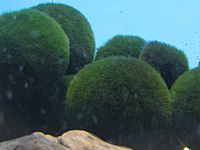
Photo from wikipedia
Glaciers support diverse ecosystems that are largely comprised of microbial life. However, at larger, macroscopic scales, glacier moss balls (sometimes called “glacier mice”) can develop from impurities on ice surfaces and… Click to show full abstract
Glaciers support diverse ecosystems that are largely comprised of microbial life. However, at larger, macroscopic scales, glacier moss balls (sometimes called “glacier mice”) can develop from impurities on ice surfaces and represent a relatively rare biological phenomenon. These ovoid-shaped conglomerations of dirt and moss are only found on some glacier surfaces and provide key habitats for invertebrate colonization. Yet, despite their development and presence being widely reported, no studies of their movement and persistence across years have been conducted. This knowledge gap is particularly important when considering the degree to which glacier moss balls may represent viable, long-term biotic habitats on glaciers, perhaps complete with their own ecological succession dynamics. Here, we describe the movement and persistence of glacier moss balls on the Root Glacier in southcentral Alaska, USA. We show that glacier moss balls move an average of 2.5 cm per day in herd-like fashion initially to the south and later towards the southwest, and their movements are positively correlated with glacier ablation. Surprisingly, the dominant moss ball movement direction does not align with the prevailing wind or downslope directions, nor with the dominant direction of solar radiation. After attaining a mature size, glacier moss balls persist for many years, likely in excess of 6 years. Finally, we observed moss ball formation on the Root Glacier to occur within a narrow, low albedo stripe downwind of a nunatak, a potential key source of moss spores and/or fine-grained sediment that interact to promote their formation.
Journal Title: Polar Biology
Year Published: 2020
Link to full text (if available)
Share on Social Media: Sign Up to like & get
recommendations!